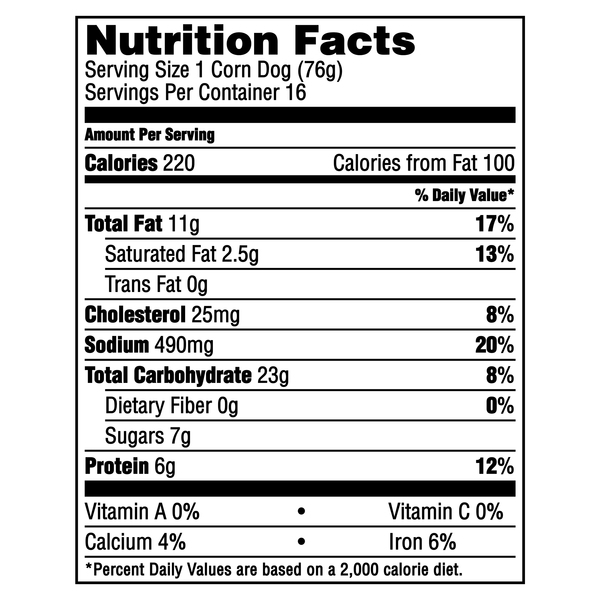Nutrition facts corn Dog is a common snack at fairs and sporting events.
Nutrition facts, corn dog, what your dogs eat is essential to maintaining a healthy lifestyle. Corn dogs have special nutritional needs. Help your dog make better eating choices; these facts may be known. In this blog, we’ll look at the nutritional facts of a corn dog.
You will learn all there is to know about calories, fat, protein, and carbohydrates. this helps your dogs get the most out of corn dogs Knowing. The details and see what’s in this well-liked treat.
An Overview of Corn Dogs
The classic American food known as a corn dog is popular with many people. It is a hot dog covered in a thick layer of cornmeal batter. Corn dogs are usually deep-fried till golden brown. This meal is well-liked during athletic events, fairs, and carnivals. They are simple to eat right away since they are often served on a stick.
The Background of Corn Dogs
The early 1900s saw the invention of the corn dog. Some claim that it was first made in the United States. Despite several sources claiming credit, the exact inventor is still unclear. Corn dogs were very popular in the 1940s. They were well-liked at state fairs and in concession stands.
The Popularity of Corn Dogs
A national favorite in recent years has become corn dogs. They are a staple at many events and gatherings. Supermarkets and fast-food restaurants carry them. It may be found in small quantities for a fast snack as well. They are well-liked because of their tasty inside and crispy outside.

Components of Corn Dogs
A common food that many people enjoy is corn dogs. Facts about nutrition. However, how is a corn dog made? The items’ nutritional worth may help you make well-informed decisions Having knowledge. the main ingredients and often additional ingredients of corn dogs Let’s examine.
Principal Elements
A few staple components are needed to make corn dogs. Their distinct flavor and texture are a result of these ingredients:
- The core of a corn dog, which can be made from beef, pig, or turkey, is called a “hot dog.”
- A combination of cornmeal, flour, and sugar is called cornmeal batter. The hot dog is coated with this batter.
- Oil: A culinary ingredient. Vegetable and canola oils are examples of common oils.
Typical Additives
Corn dogs may have a variety of other additions in addition to the main ingredients. These ingredients improve shelf life, taste, and texture.
- Use preservatives like sodium nitrate to keep the hot dog fresh.
- Monosodium glutamate (MSG) is a type of flavor enhancer that improves taste.
- Agents for coloring To make it seem better, use hues like annatto or caramel.
- To preserve texture, stabilizers use wheat gluten or soy protein.
Assist you in choosing healthier foods can Knowing these chemicals. Always look for particular information on the package.
Content of Nutrients
Choosing educated food decisions may be aided by knowing a corn dog’s nutritional statistics. This section breaks out the key components, such as calories and macronutrients.
Calories
Calories are the source of energy. However, overindulgence might lead to weight gain. A typical corn dog has between 200 and 250 calories.
Macronutrients
The macronutrients are the nutrients that your body needs in large amounts. These include proteins, fats, and carbohydrates. Here’s a synopsis:
- Protein: 6-8 g
- Fat: 10-12 g
- Carbohydrates: 20-25 g
Tissue growth and healing are facilitated by proteins. Fats promote cell development and release energy. The body uses carbohydrates as its primary energy source. You might be able to keep your diet more balanced if you are aware of these figures.
Health Effects
The Nutrition Facts corn dog is a well-liked carnival treat with a delicious blend of tastes. However, how does it affect your health? Here, we’ll talk about the potential benefits and drawbacks of eating corn dogs.
Benefits
Despite their unfavorable reputation as junk food, corn dogs are really rather nutritious. Let’s take a closer look at this:
- Protein Source: The hot dog within is a fantastic source of protein.
- Quick Energy: The maize batter’s carbs provide you with energy rapidly.
- Iron and Zinc: The flesh of hot dogs contains essential elements like iron and zinc.
Protein facilitates muscle repair. Carbohydrates provide rapid energy. Iron and zinc are essential for immune system function.
Potential Risks
Although corn dogs have certain advantages, there can also be risks.
- High Calories: Eating corn dogs might cause weight gain because of their high calorie content.
- High Fat Content: Among these are heart-harming saturated fats.
- Sodium Levels: Hypertension may result from elevated salt levels.
Obesity may result from consuming too many calories. Cholesterol is elevated by saturated fats. Elevated salt levels can raise blood pressure.
The nutritional data for a normal corn dog of the following is a quick summary:
- Calories: 200-250 g
- Protein: 6-8 g
- Fat: 12-15 g
- Sodium: 600-800 mg
To maintain a balanced diet, eat corn dogs in moderation. Consider healthier alternatives or serve them with nutrient-dense sides.
Brand Comparison
The healthiest and tastiest corn Canine Comparing brands to obtain possibilities may help you choose the greatest corn dog. There are benefits and drawbacks to both homemade and store-bought corn dogs. To further grasp the distinctions, let’s examine the specifics.
Store Purchased vs. Homemade
Corn dogs from the store are simple to make and convenient. They are a beneficial option for hectic families because they are available in a variety of flavors and sizes. Here are a few instances of typical characteristics:
- frozen and precooked
- There are several brands available.
- extended shelf life
- Taste consistency
Making your own corn dogs also gives them a unique look. You have control over the ingredients and may choose healthier ones. Following are some examples of typical traits:
- Fresh ingredients
- Customizable recipes
- Fewer preservatives
- Potentially healthier
Popular Brands
There are several well-known brands of corn dogs available. Each has unique health advantages and flavors. Some well-known businesses and their offerings Let’s look at.
- Calories: Brands A, B, and C are 220, 200, and 250.
- Fat: 11g for Brand A, 9g for Brand B, and 13g for Brand C.
- Protein: 7g for Brand A, 6g for Brand B, and 8g for Brand C.
- Sodium: 500g for Brand A, 550g for Brand B, and 450g for Brand C.
With a reasonable fat and calorie content, Brand A is a well-rounded choice. Brand B is a lighter option since it has a little less fat and calories. Despite having more protein, Brand C contains the most calories.
Your dietary requirements and taste preferences will determine which nutrition facts, corn dog, is best for you. Everyone can find their ideal corndog, regardless of whether they prefer the convenience of store-bought ones or the freshness of homemade ones.
Aspects of Nutrition
Despite their popularity and nutrition facts, corn dogs come with dietary limitations. Because of allergies or personal preferences, some individuals may need to avoid particular components. Here is where you can find out more about corndog alternatives.
Gluten-free Options
People with celiac disease or gluten intolerance may have trouble eating a regular corn dog. Fortunately, there are gluten-free substitutes. These corn dogs include a hot dog coated in gluten-free flour.
Follow are common gluten-free flours:
- Flour made from rice.
- Flour made from corn.
- Flour made from almond.
- Flour made from coconut.
Check the Always label to make sure the product is gluten-free. This prevents cross-contamination with gluten-containing items.
Alternatives for Vegetarians
Nutrition facts: Vegetarians can also enjoy corn dogs. Use a plant-based sausage in place of a meat hot dog.
Among the most popular vegetarian sausages are:
- Sausage made with soy
- Sausage made with tofu
- Sausage made with seitan
- Tempeh sausages
These sausages are delicious and high in protein. Add a blend of cornmeal and other seasonings that are suitable for vegetarians.
To compare vegetarian sausage choices, use this straightforward table:
- 8 g of tasty soy-based taste.
- 10 g of mild-flavored tofu.
- 25 g of rice-flavored seitan.
- 21 g of nutty taste.
These options provide a tasty and healthy alternative to traditional nutrition facts: corn dog. Perfect for those who want a plant-based diet.
Corn Dogs In Different Cultures
Nutrition facts: Corn dog is a popular food in many countries. They differ in their names and styles. The underlying idea remains unchanged. A sausage is coated with a thick coating of cornmeal batter and deep-fried. An own twist to this traditional food each tribe adds. The differences in corn dogs throughout the world Let’s look at.
Corn Dogs in America
Nutrition facts: corn dog is a mainstay at fairs and carnivals in the United States. They are often served with mustard or ketchup. Typically, beef or pork sausage is used to make the American corn dog. The little sweetness of the cornmeal batter gives it a unique flavor.
American corn dogs often exhibit the following traits:
- Sausage produced from either pork or beef
- The batter is made with somewhat sweet cornmeal.
- Served with mustard or ketchup.
International Variations
In many other nations, corn dogs have become more and more popular. Every nation has a distinct variant. Following are a few instances:
- South Korea: Also known as “hotteok.” Often loaded with cheese and dusted with sugar.
- Japan: As “American dogs” to refer. With fish sausage, they are served with mayonnaise after being grilled.
- Australia: As “pluto pups,” they are known to be served with tomato sauce.
Nutrition facts: corn dog true adaptability these international versions demonstrate. Every culture contributes elements and tastes. Nutrition facts: The corn dog is hence popular all across the world.
Choosing Healthier Options
Improving your diet and general health might make better decisions. Nutrition facts: corn dog is heavy in calories and frequently deep-fried A common snack. different cooking techniques and toppings with By experimenting, this delicious dessert of yours may create healthier versions.
Baking Vs Frying
When creating corn dogs, baking is preferable to frying. The corn dog has less fat overall since baking consumes less oil.
According to the graphic, baked corn dogs have fewer calories and fat than fried ones. Before baking, preheat your oven to 375°F (190°C). Put the corn dogs on a baking sheet and cook until golden brown, 15 to 20 minutes.
Nutritious Toppings
Improve its flavor to add healthy toppings to your corn dog. Steer clear of high-calorie condiments like cheese and mayonnaise. That offer both taste and nutrition instead Select alternatives.
- Mustard: provides a zesty flavor and is low in calories.
- Fresh salsa: rich in vitamins and low in calories.
- Guacamole is rich in healthy fats and adds smoothness.
- Pickles: Add a little sourness and crunch.
You may increase your corn dog’s nutritional value by adding these toppings. They also improve the enjoyment of the meal without consuming more calories.
In conclusion, utilizing nutritious toppings and baking corn dogs rather than frying them are two ways to make healthier choices. You may still enjoy your favorite snack and maintain a balanced diet by making these changes.
FAQ
What Is a Corn Dog Nutritious?
Corn dogs are high in calories, fat, and salt. Sometimes as a treat.
What is the corn dog of calorie content?
The average corn dog contains 200–250 calories. Depending on the size and brand, this might change. For precise nutritional information, always tick the box.
What is the protein content of a corn dog?
A corn dog has 6–8 grams of protein, typically. A given product might vary in the amount of protein.
Are corn dogs free of gluten?
corn dogs in most, gluten is present. They use wheat flour in their batter. Seek out options marked as gluten-free if required.
Summary
Nutrition facts: corn dog Improving healthier dietary choices is aided by being aware. They also provide protein, but they include calories and fats. Eat fruits and vegetables to balance them out. Eat corn dogs in moderation for a healthy diet. Remember that every little change contributes to a healthy lifestyle.
Eating healthy involves making sensible choices and keeping things in balance. Enjoy the occasional treat, but be mindful of your overall diet.












